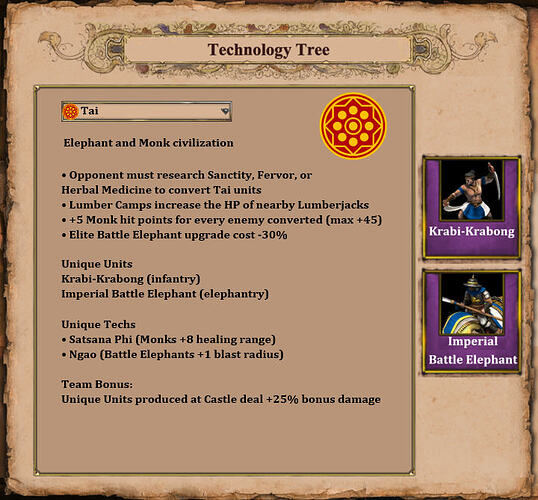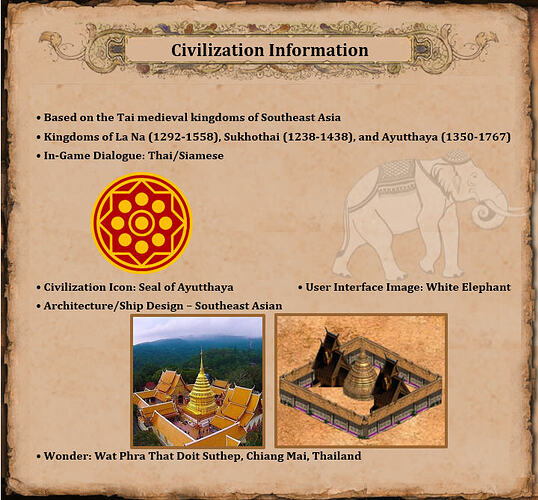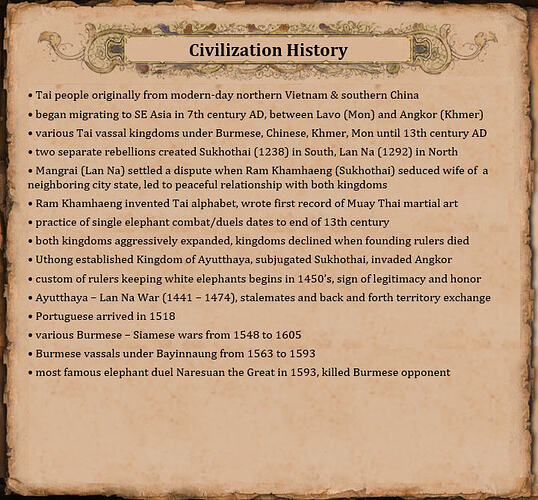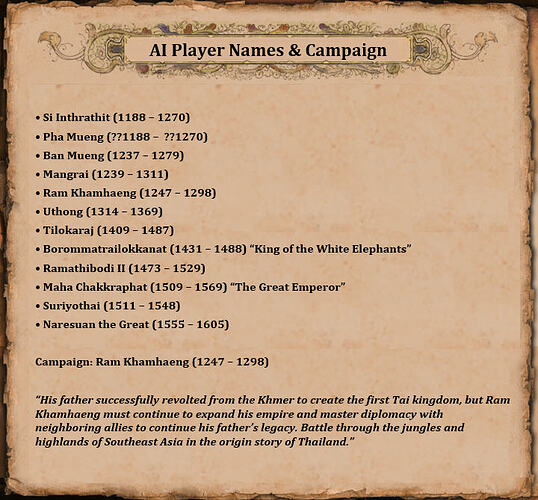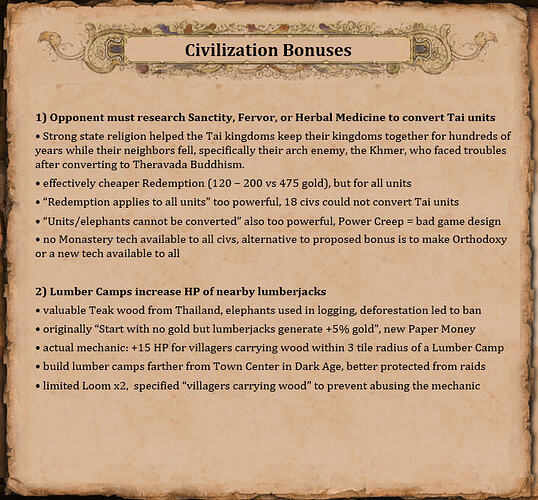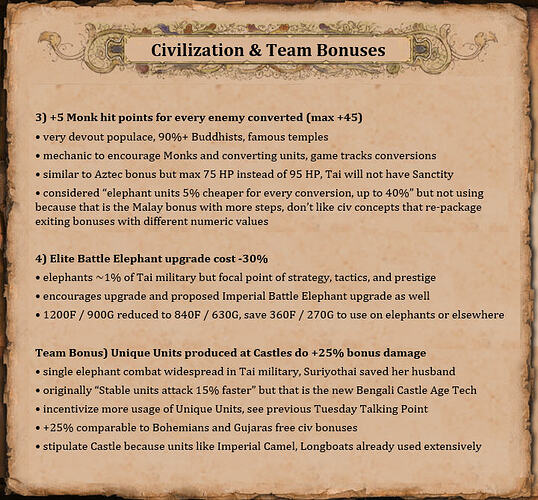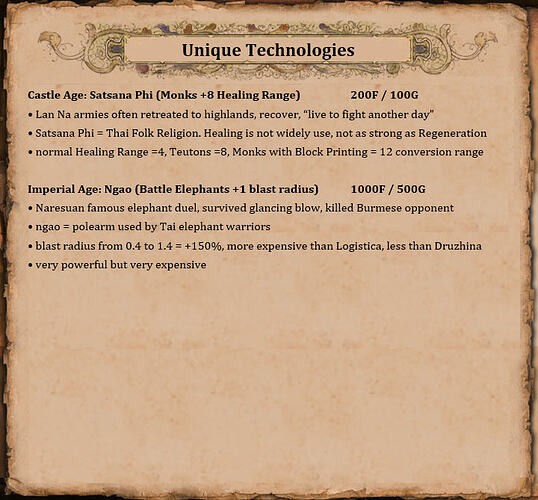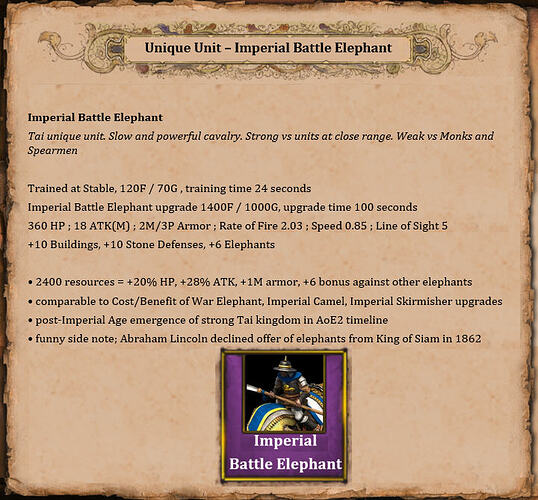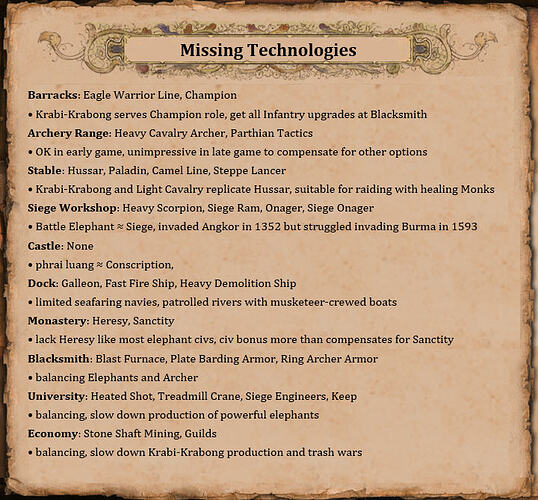Tai
Monk & Elephantry Civilization
Based on the Kingdoms of La Na (1292-1558), Sukhothai (1238-1438), Ayutthaya (1350-1767)
Distinct Tai population Around 638 – On
1) Civilization History
The Tai peoples, originally from modern-day northern Vietnam and southern China, began to leave the Far East and settle in Southeast Asia in the lands between the Mon Kingdom of Lavo and the Khmer Empire in Angkor during the 7th century AD. Various Tai Kingdoms existed for hundreds of years as vassals to the Burmese, Chinese, Khmer, and Mon, but two separate rebellions in the 13th centuries created what would become two independent neighboring Tai kingdoms; Sukhothai (1238 AD – 1438 AD) in the southern river valleys and Lan Na (1292 AD – 1558 AD) in the northern highlands.
In 1238 AD, two friends and Pho Khun’s, or local leaders, Si Inthrathit (born Bang Klang Hao in 1188 AD – 1270 AD) and Pha Mueang (?? Late 13th century– ?? Mid 14th century) overthrew the Khmer Empire’s local governor in southern modern-day Thailand and created the Kingdom of Sukhothai, which historians attribute to be the first Siamese dynasty and the beginning of what would become Thailand. Another rebellion in 1292 in the northern highlands by Mangrai (1239 AD – 1311 AD) would create the Kingdom of Lan Na, and he established a peace with Si Inthrathit’s son Ram Khamhaeng (1237 AD – 1298 AD), which as legend has it says included settling a dispute after Ram seduced the wife of the King of Phayao, a city state in northern modern-day Thailand.
During the latter part of the 13th century, both kingdoms aggressively expanded and subjugated the surrounded areas, and Ram Khamhaeng invented the Thai alphabet. But upon the deaths of their founding leaders, both kingdoms saw their power and influence decline. There were decades of inner conflicts and decline until 1350, when King Uthong (1314 AD – 1369) rose to power and established the Kingdom of Ayutthaya (1350 AD – 1564 AD). Uthong invaded Sukhothai in 1350 and made them a tributary state, but Sukhothai would exist as a vassal until Ayutthaya eventually ended their independent rule in 1438.
Ayutthaya would become the most powerful of the Tai Kingdoms and eventually the most powerful kingdom in all of Southeast Asia after defeating their rival, the Khmer. Uthong initially besieged Angkor in 1352, leading to nearly a century of conflict between the two empires, eventually ending with the abandonment of Angkor in 1431. Lan Na had a similar resurgence of power and expansion around this time during the reign of Tilokaraj (1409 AD – 1487 AD), but unlike Mangrai and Ram Khamhaeng before them, Tilokaraj and the Ayutthayan king Borommarachathirat II ( ?? – 1448 AD) went to war. The Ayutthaya-Lan Na War began in 1441 and lasted until 1474, mostly ending in stalemates and modest back and forth territorial gains.
The two Tai kingdoms fought small conflicts for several decades but were not major threats to each other. That threat came from the west, as the Burmese line of rulers from the Toungoo Dynasty rose to power in the first half of the 16th century. Led by Bayinnaung (1516 AD – 1581 AD), the Burmese took control of La Na in 1558 and Ayutthaya in 1564. While La Na was under Burmese control for the next 200 years, Ayutthaya once again became an independent kingdom in 1593 AD after Naresuan the Great (1555 AD – 1605 AD) defeated the Burmese in a battle that, as legend has it, included single combat via an elephant duel with the Burmese heir-apparent, ending the Burmese-Siamese War (1593-1600) and established Tai rule that exists to this day.
2) AI Player Names
Si Inthrathit (1188 – 1270)
Born as Bang Klang Hao, led the Khmer vassal territory of Bang Yang before rebelling with Pha Mueng in 1238 and established the Kingdom of Sukhothai, where he reined for 32 years from 1238 – 1270. Credited as the founder of the first Siamese dynasty and the first independent Tai kingdom.
Pha Mueng (?? 1188 – ?? 1270)
Led a Khmer vassal territory before rebelling with Si Inthrathit to establish the Kingdom of Sukhothai.
Ban Mueang (1237 – 1279)
Son of Si Inthrathit and older brother of Ram Khamhaeng. King of Sukhothai for 9 years from 1270 – 1279.
Mangrai (1239 – 1311)
After leading the Mon vassal Kingdom of Ngoenyang for 31 years from 1261-1292, defeated the Mon, established the Kingdom of Lan Na, and ruled for 19 additional years as the first King of Lan Na from 1292 to 1311. Maintained a peace with the Sukhothai leader Ram Khamhaeng.
Ram Khamhaeng (1247 – 1298)
Son of Si Inthrathit and younger brother of Ban Mueang, King of Sukhothai, ruled for 19 years from 1279-1298. Credited with creation of Thai alphabet and the first written text on Muay Thai. Maintained a peace with Lan Na leader Mangrai.
Uthong (1314 – 1369)
Established the Ayutthaya Kingdom and reined for 20 years from 1350 to 1369, subjugated the Kingdom of Sukhothai, and invaded the Khmer capital of Angkor.
Tilokaraj (1409 – 1487)
King of Lan Na for 46 years from 1441 to 1487. Expanded the Lan Na Kingdom to its largest extent and invaded Ayutthaya during the Ayutthaya-Lan Na War (1441-1474).
Borommatrailokkanat (1431 – 1488) “King of the White Elephants”
King of Ayutthaya for 40 years from 1448 – 1488. Repelled La Na during the Ayutthaya-
Lan Na War (1441-1474) and was the first Tai king to own a white elephant.
Ramathibodi II (1473 – 1529)
Son of Borommatrailokkanat, King of Ayutthaya for 38 years from 1491 to 1529. Made
first contact with Europeans when the Portuguese arrived in 1518.
Maha Chakkraphat (1509 – 1569) “The Great Emperor”
King of Ayutthaya for 16 years from 1548 – 1564 and again briefly in 1568 – 1569. Lost control of the Tai kingdoms to the Burmese, became a Buddhist monk during four years as a hostage, convinced Bayinnaung to release him, returned to start revolt.
Suriyothai (1511-1548)
Wife of Maha Chakkraphat, gave her life defending her husband by a single-combat elephant duel against the Burmese
Naresuan the Great (1555 – 1605)
King of Siam for 15 years from 1590 to 1605. Freed Tai from Burmese vassalage, legendarily defeated Burmese heir-apparent in single-combat elephant duel. Established Tai rule that exists to this day.
3) Age of Empires 2 Civilization Information
In-Game Dialogue Language – Thai/Siamese
Civilization Icon – Seal of Ayutthaya
User Interface Image – White Elephant
Architecture/Ship Design – Southeast Asian
Wonder – Wat Phra That Doi Suthep
Campaign – Ram Khamhaeng (1247-1298)
This campaign would be the origin stories for the first two kingdoms that would come to be known as Thailand. Si Inthrathit and his son Ram Khamhaeng started the Suhothai Kingdom in southern modern-day Thailand, while Mangrai formed the Kingdom of La Na in modern day northern Thailand. Both kingdoms stepped out from under their vassalage yokes and fought for their own sovereignty.
This would work nicely as a Co-Op Campaign. The two kingdoms cooperated and had friendly diplomatic relations, and I view this campaign as largely comprised of split maps, with two factions separated by cliffs or an unpassable river the length of the map and coming together at the end, similar to the Genghis Khan “The Horde Rides West” scenario. Existing AoE2 civilizations that could appear would be Khmer, Burmese, Chinese, and Vietnamese.
While Ram Khamhaeng is regarded as a Thailand national hero, a later campaign might make sense to emphasize the slow rise of the Tai and their dominance of Southeast Asia towards the end of the AoE2 time period. Later options for the Tai campaign could cover Uthong starting the Ayutthaya Kingdom in 1350 and fighting the Khmer, or Naresuan the Great rebelling against the Burmese as part of a post-Bayinnaung campaign, starting with his stint as Bayinnaung’s royal hostage in 1564 and eventually re-establishing the Tai sovereignty that exists to the present today.
As far as other campaign appearances, the Tai would replace the Burmese as Lavo Kingdom and Hariphunchai in the fifth scenario “Nirvanapada” in the Khmer Suryavarman I campaign, and replace Khmer as the Mountain Thai, Ayutthaya, and Lan Na in the fourth scenario “The White Elephant” in the Burmese Bayinnaung campaign. Lan Xang could be left as Khmer just for variety.
4) Bonuses and Unique Technologies
4.1) Opponent must research Sanctity, Fervor, or Herbal Medicine to Convert Tai units
Tai kingdoms existed for hundreds of years without being toppled, and their strong state religion helped keep their kingdoms together where they neighbors fell, specifically their arch enemy, the Khmer, who faced troubles after converting to Theravada Buddhism. These three technologies were chosen because every civilization has access to at least one of them, and they have similar gold costs. This is effectively a cheaper Redemption mechanic, at 120 to 200 gold instead of 475, but for all units and an added protection for the Tai elephants.
There are no existing Monastery technologies available to every civ, but the aforementioned three are available to 36 (Sanctity) and 38 (Fervor, Herbal Medicine) of the 42 civs. The Saracens and Slavs both just had Monk related Unique Technologies replaced, indicating those technologies likely were not used very much and further illustrating the potential to increase Monk play. For example, I think Orthodoxy is the more useful of the two removed Unique Technologies, so make it a Monastery technology available to all civilizations in the Castle Age, tweak the Armor increases to +1M/+1P for balance reasons, and change the cost to ~200G.
Alternatively, a new Monastery technology could be created that is available to all civilizations to streamline this mechanic a little more. Something like “Pilgrimage - Relics generate X% gold for Allies” to dissuade any potential awful teammates from sending onagers to Attack Ground you since you “stole” their relic.
I did not want to make this mechanic “Redemption applies to all units” because that effectively means 18 civilizations cannot convert any Tai units, which seems game breaking. I also did not want to make the mechanic just a broad “units/elephants/unique unit cannot be converted” because that seems like too much of a Power Creep.
- My original second bonus was “Start with no gold, but lumberjacks generate +5% gold” which has obviously since been used for the reworked Vietnamese Imperial Unique Tech Paper Money. Here was my original write-up that I think pretty neatly tied together aspects of Thailand’s logging industry history and made it function as a game mechanic.
Start with no gold, but lumberjacks generate +5% gold – Removed
The Tai might have started out as vassals in the 7th century but became the most powerful civilization in Southeast Asia by the 15th century. Thailand has a contentious relationship with logging, as Teak wood from Thailand is often regarded to be some of the finest lumber for carpentry, but Thailand has been heavily deforested to the point the government banned logging in 1989 and has to limit illegal harvesting. Elephants were used extensively in the Tai logging industry, so this is another reference to the strong impact of elephants on this AoE2 civ, and is a similar vein to the Burmese free Lumber Camp technologies. This bonus is meant to reflect that while they came from humble origins, as they grew, they had access to more resources. As a game mechanic it helps the Tai pay for their expensive elephants in the late game or in a 1v1 match-up, and is another reminder that AoE2 civilizations are terrible stewards to their environment, with clear-cutting forests, hunting and fishing animals to extinction, and unsustainably mining precious minerals!
While I am glad the Vietnamese got a new technology and the developers seem to be moving away from one-time bonuses, I am disappointed that I won’t get to use this technology. So instead I am proposing a different bonus.
4.2) +15 HP for villagers carrying wood within a 3-tile radius of a Lumber Camp
The Tech Tree would show “Lumber Camps increase HP of nearby lumberjacks” to keep the text length manageable, with the remaining information buried in the Genie Editor or AoE2 Wiki page.
This is an abstract interpretation of the aforementioned wide-spread logging in Thailand. In the same way that illegal logging is difficult to stop, Tai lumberjacks will be very hard to kill by raiding since they effectively double up on Loom. It could encourage a Tai player to be more aggressive and place a Lumber Camp in the Dark or Feudal Age that they normally might not due to the distance from the Town Center and the danger of raids. Similar to the Khmer house garrison, Tai players would be a little more protected from early game wood-line raiding, except they actively fight instead of hiding from a Scout Rush.
This technology specifically limits the effects to villagers carrying wood so players cannot just build Lumber Camps around their base to serve as shield generators for all their villagers by quickly assigning them to Lumberjacks, although I’m not sure how viable this is from a programming standpoint. It seems to function very similarly to the new Caravanserai building for the Hindustanis.
The Tai’s other bonuses only apply starting in the Castle Age so they needed an early game bonus. Spanish players get +40 HP for all their villagers, among other bonuses, from their Imperial Age technology Supremacy and Bohemian Villagers get +15 HP with Sanctity, so with the limits imposed on the Tai bonus, it seems fair for a free Civ Bonus.
4.3) Monks gain +5 HP for every enemy military unit converted, up to +45 HP
Thailand was ranked the 13th most devout country in 2020, with 97% of citizens saying they are religious. Thailand also has the second highest percentage of its population following Buddhism at 92.6% and has the most Buddhist followers of any country outside of China. Taking this into account along with the many famous Buddhist temples in the country, including the Wat Phra That Doi Suthep that I proposed as this civ’s Wonder, the Tai would be a strong Monk civ.
This is in the same vein of the first bonus where the Tai kingdoms relied on strong state religions to maintain order, but also a game mechanic to give this civ really good Monks. Since they get this HP boost, they do not have access to Sanctity, which would normally give Monks +15 HP. This is a somewhat similar mechanic to the Aztec civ bonus for +5 HP for every monastery tech, and since the game tracks units converted, it should be something that is doable. Tai players that take full advantage of this bonus would have the second highest HP Monks in the game, second only to the Aztecs.
I decided against the possible bonus “Elephant units 5% cheaper for every enemy military unit converted, up to 40%” since it is basically the same as the Malay bonus just with more intermediate steps and I do not like civ concepts that just use different numeric values for existing bonuses. It was another way to implement the same premise of incentivizing using Monks to convert units with the added bonus of reducing elephant cost, which is always their main drawback.
4.4) Elite Battle Elephant Upgrade costs 30% less
Yet another bonus that is alluding to a historical aspect of the civilization while also encouraging a particular playstyle. The militaries of the Tai Kingdoms were comprised of only ~1% elephantry, but their entire strategy and tactics were based around using their impressive units. This bonus entices the player to not only get to Elite Battle Elephants at a reduced cost, but to go a step further and research the Tai’s Regional Imperial Unit, the Imperial Battle Elephant. The Elite Battle Elephant Upgrade is 1200F / 900G, so 30% cost reduction gets to 840F / 630G, a reduction of 360F and 270G, enough resources for 3 additional Battle Elephants with 60G to spare. The Imperial Battle Elephant Upgrade is 1400F / 1000G, making it only slightly cheaper than the Persian’s Elite War Elephant Upgrade of 1600F / 1200G. In all, upgrading to Imperial Battle Elephant costs 2240F / 1630G, an incredibly expensive upgrade, but one that gives access to a borderline unstoppable army if given the chance to mass.
Castle Age Unique Tech)
Satsana Phi - Monk Healing Range +8 Research Cost 200F / 100G
The armies of the Lan Na Kingdom would often retreat to “live to fight another day” only to come back healed and stronger. Satsana Phi is Tai folk religion. This is another Monk bonus for the Tai, making them a formidable Monk civ and giving them an advantage in a lesser used mechanic, hence the low cost. Normal healing range is 4 but Teuton monks have 8. Monks with Block Printing have 12 conversion range, a Tai monk would the same range for healing. This gives the Tai army a way to regain health on the battlefield, but not quite as strong as a regenerative health bonus, and is another push to use Monks.
Imperial Age Unique Tech)
Ngao – +1 Blast Radius of Elephants Research Cost 1000F / 500G
Naresuan the Great is famous for his legendary single-combat elephant fight in 1593 with the Burmese heir-apparent, where he was able to survive a glancing blow from his enemy and then later kill him with his spear. His Ngao and Helmet are on display in a pagoda built on the site of the battlefield. This is where the Tai Battle Elephant gets really, really scary. With an increase in their base Blast Radius of 150%, it is obvious why this technology is so expensive, costing slightly more than the Byzantine technology Logistica, which increases Blast Radius by 0.5 tiles and gives a +6 Infantry attack bonus. This turns their Cataphracts into much more deadly units. But similar to the Byzantines, all of these upgrades are incredibly expensive, so the unit itself might be the best individual unit in the game, but it will take a huge investment to get there.
Team Bonus) Unique Units produced at Castles do +25% bonus damage
In another single-combat elephant fight in 1548, Maha Chakkraphat went rushing into battle to face his Burmese foe, and was saved by the sacrifice of his wife Suriyothai, who also raced into battle on her own elephant and fought the Burmese enemy, giving her life. This was originally supposed to be “Stable units attack 15% faster” but that is the Bengali’s new Castle Age Unique Tech, so I pivoted to something I think I like more than my original idea. This is a mechanic to incentivize players to make use of their Castle Unique Units, which as evidenced by my Tuesday Talking Point from last week, are not thought of as the primary military unit for most civs due to coming from Castles, being hard to mass, or replicated by standard units. 25% seemed in line with the Bohemians and Gujaras free civ bonuses for Spearmen and Mounted units, respectively.
I stipulated produced at the Castle because units like Imperial Camel and Genitours already see extensive use on land, similar to the prevalence of Longboats and Caravels on the water. I believe that the game tracks Huskarls and Tarkans that are produced at Barracks and Stables as opposed to the Castle, so this would keep their high bonus damage mostly in check. I’m unsure about the new Dynasties of India Unique Units, but otherwise there are four Unique Units that have no Bonus Damage; Burgundian Coustilliers, Lithuanian Leitis, Slav Boyars, and Tatar Keshiks, but there are many Team Bonuses that do not apply to every civilization. While this bonus would help all remaining unique units, I think it would help the units that have large bonuses like Jaguar Warriors and Mamelukes. I am unsure if this would apply to Flaming Camels, but if so would make them a little better but still not anywhere near as good as Petards, but ironically enough would make them probably the best elephant counter.
5) Unique Units
5.1) Krabi-Krabong
Tai unique infantry unit with two quick attacks. Strong vs Monks and Spearmen. Weak vs Archers.
The Tai’s Unique Unit they produce at the Castle is the Krabi-Krabong, a medium HP, low armor Infantry unit with a double attack that specializes as an Anti-“Elephant Counter” Infantry.
o 60F/30G; Training Time 12sec; Elite Upgrade 1000W, 300G, 45sec
o 50/70 HP; 8/10 ATK(M) 1st hit, 3 ATK(M) 2nd hit; 1M/0P AMR; 2.03 ROF; 1.10 SPD
o LOS 5/6; +3 Eagle Warrior, +5 Buildings, +8 Monks, +4 Spearmen
Tai soldiers would learn Krabi-Krabong and Muay Thai from Monks along with religion and other teachings, so these Tai Warrior Monks were very similar to the Cristian military orders of Europe and making this unit sound like a Southeast Asian Teutonic Knight. However, these units do not have a Conversion resistance, but rather an explicit Attack Bonus against Monks. With the Tai’s excellent elephants and, of course, no access to Heresy, no doubt that enemies will attack the Tai’s elephants with Monks and Spearmen. But this unit is meant to defend the elephants, much like the real Tai warriors were instructed to do. The elephant’s legs were the weak spots, so they had to be guarded by four soldiers to protect the elephants, so they have bonuses against the elephants’ two main counters. While the unit itself costs Food and Gold, the Elite Upgrade costs Wood and Gold so that the Food can be used for elephants and other upgrades.
Krabi-Krabong practitioners had many weapons at their disposal, with sword, staff, club, and baton in the armory. They are one of the very few instances of dual wielding in historical martial arts or combat, so the double attack is a cool way to replicate something usually reserved for fantasy, and is the Chu Ko Nu and Kipchak mechanic in a Melee form. With the second attack they will be helpful against high Melee armor units as well as low HP units. That leaves high HP units and Archers as their counters.
The name of this unit is just “Krabi-Krabong” and not “Krabi Warrior” or “Krabi-Krabong Swordsman” because I’m not really a big fan of the recent trend of naming Unique Units “weapon name” Warrior, but also because they have a wide variety of weapons to use. The unit in game could have two Daab swords, one Krabi sword and one Krabong staff, or two Mai sok san forearm clubs.
5.2) Imperial Battle Elephant
In my Tuesday Talking Points post all the way back in 2020, I talked about Special Regional Imperial Units. The Battle Elephant is that unit for Southeast Asia civs, and since adding a unit to the Tai is preferable to a current civ, they get the Imperial Battle Elephant, which has been alluded to a couple times. Here are their stats:
o 120F, 70G; Training Time 24sec; Upgrade 1400F, 1000G, 100sec
o 360 HP; 18 ATK(M) ; 2M / 3P AMR; 2.03 ROF; 0.85 SPD; 0.4 RAD
o LOS 5; +10 Buildings, +10 Stone Defenses, +6 Elephants
For 2400 resources, you get a 20% increase in HP, 28% increase in Attack, +1 Melee Armor, and a +6 Bonus against other Elephants. I arrived at these numbers because they are all comparable to the Cost/Benefit and raw increases seen in the Persian War Elephants, Hindustani Imperial Camels, and Vietnamese Imperial Skirmishers, which I viewed as similar upgrades.
This unit, literally and figuratively, is a beast. If a Tai player could muster the resources to get to this unit and mass an army of them, with proper support units around them to protect their weaknesses, that creates another Battle Elephant Deathball similar to the Khmer, ironically the arch-enemy of the Tai. It is another reference to the Post-Imperial emergence of a strong Tai civilization, as the Kingdom of Siam grew to be an influential world power in SE Asia. While it is well outside of the timeframe of AoE2, and possibly even AoE3, it is humorous to consider that in 1862, Abraham Lincoln had to reject an offer of sending elephants to the United States from King Somdetch Phra Paramendr Maha Mongut of Siam, ostensibly to use in the aforementioned logging industry but the image of an Elephant Corp charging across the battlefield at Gettysburg is something that the world missed out on.
6) Missing Technologies
Barracks: Eagle Warrior Line, Champion
Archery Range: Heavy Cavalry Archer, Parthian Tactics
Stable: Hussar, Paladin, Camel Line, Steppe Lancer
Siege Workshop: Heavy Scorpion, Siege Ram, Onager, Siege Onager
Castle: None
Dock: Galleon, Fast Fire Ship, Heavy Demolition Ship
Monastery: Heresy, Sanctity
Blacksmith: Blast Furnace, Plate Barding Armor, Ring Archer Armor
University: Heated Shot, Treadmill Crane, Siege Engineers, Keep
Economy: Stone Shaft Mining, Guilds
7) Civilization Overview
With their bonus against Spearmen, the Krabi-Krabong are the Tai’s best counter to Late-Game Halberdier spams, which is usually the only time that Champions see action and justifies their removal from the tech tree for balance reasons. But since the Krabi-Krabong come from a Castle and not a Barracks and cost 10 more Gold, the Tai are not totally immune from the main counter to their elephants. While elephants were the flashy focal point of the Tai military, their army was still upwards of 90% infantry who were well-trained in martial arts, so they get all the Infantry upgrades at the Blacksmith.
In a similar vein, the Krabi-Krabong is a suitable but not perfect replacement for the Hussar as an anti-Monk unit. They end up having a slightly higher Attack against Monks with their base and bonus Attacks, but Hussars are 36% faster and thus can close in on Monks quicker, although since Monks only have a 0.70 Speed, the Krabi-Krabong can still catch up. Where the Tai will miss Hussars is for Raiding, but with their long-range healing Monks they can send in Light Cavalry then retreat and heal. Their already super tanky elephants, which lend themselves to a Scorched Earth, Frontal Assault tactic instead of Raiding, means they need to have the last Cavalry Attack and Armor upgrades removed but still retain Bloodlines, and get Husbandry so they still have the ability to use fast units.
Similar to the Siege Elephant for the new Dynasties of India civs, the Tai Battle Elephant will be their de facto Siege Unit. While the Tai were mostly successful at invading and laying siege to Angkor in 1352, they struggled mightily in their sieges of the Burmese-Siamese War (1593-1600) and as such, they lack the late-game Siege upgrades of the Siege Engineers technology and the final upgrades to ANY of the Siege Units, and in fact join the Huns and Turks as the only civs to not even have the Onager. This is to compensate for the fact that Tai Battle Elephants with the Imperial Age Unique Tech will do a significant amount of Blast Damage, and to represent the fact the Tai did for fare very well when trying to invade Burma. This is not an all-bad thing though since the Battle Elephants still have an Attack Bonus against Buildings but are much faster than typical Siege units.
The Tai still get Arbalesters but lack Ring Archer Armor, Heavy Cavalry Archers, and Parthian Tactics. Their Archery Range is OK in the early game but is pretty unimpressive in the late game to compensate for their powerful elephants, decent infantry, and good Unique Unit. Without even the Onager, a Tai player has a potential weakness to Crossbowman & Pikeman armies, but should be able to deal with them using Light Cavalry and Krabi-Krabong.
The various Tai kingdoms did not have extensive seafaring navies, instead focusing on patrolling the various inland rivers, so their Dock is below average. They do still get Elite Cannon Galleon
Because the Tai employed musketeers on their river guard ships. Their lack of Heated Shot means they will have to keep an eye on their coasts, like the Tai kings really had to do in keeping a watchful eye for the Malay.
As already discussed, they miss the Sanctity upgrade because of their more than equivalent civ bonus, and they miss Heresy like most Elephant civs do. I toyed with also removing Faith but decided against it as it runs counterintuitive to their Civ Bonus. Their ability to pump out Imperial Battle Elephants is impeded enough by their borderline prohibitive cost, and the fact they are missing Treadmill Crane so cannot throw up Stables as quickly.
I see the Tai ideal army composition to be mainly Battle Elephants with a complementing Infantry unit of some kind, be it Krabi-Krabong or a more generic unit like Halberdier, and then Arbalesters or Bombard Cannons as Ranged support, all the while with Monks there to heal from a distance. They would be very good on closed maps and in late-game situations, but with the Lumber Camp bonus and standard military options they should do OK in the early-game as well. This represents the real Tai who survived as vassals in their early stages but became extremely powerful towards the end of the AoE2 timeframe.
